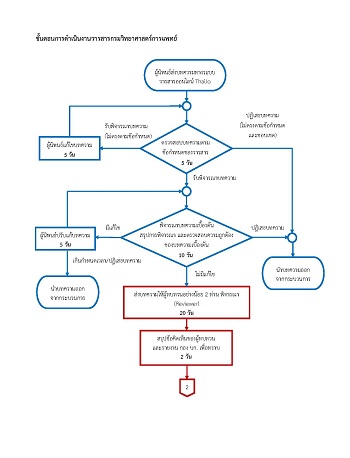การตรวจจีโนทัยป์เพศตัวอย่างดีเอ็นเอมนุษย์ โดยวิธี real-time PCR ด้วยคู่ไพรเมอร์ CDY-1
คำสำคัญ:
การตรวจจีโนทัยป์เพศ, ดีเอ็นเอมนุษย์, เรียลไทม์ พีซีอาร์บทคัดย่อ
การศึกษาความสัมพันธ์ระหว่างความหลากหลายทางพันธุกรรมกับลักษณะการแสดงออก (genotype-phenotype association study) เช่น การเกิดโรค ความรุนแรงของโรค การตอบสนองต่อยา มักใช้เทคนิคการตรวจทางพันธุกรรมที่มีขั้นตอนซับซ้อนและมีค่าใช้จ่ายสูง จึงจำเป็นต้องมีการตรวจวัดปริมาณและคุณภาพดีเอ็นเอแต่ละตัวอย่าง ซึ่งการตรวจเหล่านี้ไม่สามารถระบุการสลับตัวอย่างหรือการปนเปื้อนระหว่างตัวอย่างที่อาจเกิดขึ้นโดยเฉพาะขั้นตอนที่ทำโดยมนุษย์ การตรวจจีโนทัยป์เพศของตัวอย่างดีเอ็นเอเพื่อยืนยันว่าตรงกับบันทึกข้อมูลเพศของบุคคลในฐานข้อมูล เป็นวิธีการหนึ่งที่ช่วยเพิ่มความมั่นใจในคุณภาพผลการศึกษา จึงได้พัฒนาวิธีการตรวจจีโนทัยป์เพศด้วยเทคนิค real-time PCR ด้วยคู่ไพรเมอร์ของยีน CDY-1 บนโครโมโซม Y ผลการทดสอบประสิทธิภาพในตัวอย่างดีเอ็นเอ 377 ตัวอย่าง พบว่าให้ผลตรวจจีโนทัยป์เพศตรงกับบันทึกในฐานข้อมูลบุคคลร้อยละ 100 วิธีที่พัฒนาขึ้นสามารถนำไปใช้ตรวจเพศในตัวอย่างดีเอ็นเอจำนวนมากได้อย่างมีประสิทธิภาพ การพัฒนาให้การตรวจนี้สามารถตรวจวัดปริมาณดีเอ็นเอด้วยจะทำให้ได้วิธีตรวจที่นำไปใช้ประโยชน์ได้สมบูรณ์ขึ้น
เอกสารอ้างอิง
Sambrook J, Russell DW. Molecular cloning: a laboratory manual. 3rd ed. New York: Cold Spring Harbor Laboratory Press; 2001.
Glasel JA. Validity of nucleic acid purities monitored by 260 nm/280 nm absorbance ratios. Biotechniques 1995; 18: 62-3.
Armbrecht M, Gloe J, Goemann W. Determination of nucleic acid concentrations using fluorescent dyes in the Eppendorf BioSpectrometer® fluorescence. In: Eppendort application note 271. Hamburg, Germany: Eppendorf AG.; 2013. p.1-10.
Vitzthum F, Geiger G, Bisswanger H, Brunner H, Bernhagen J. A quantitative fluorescence-based microplate assay for the determination of double-stranded DNA using SYBR Green I and a standard ultraviolet transilluminator gel imaging system. Anal Biochem 1999; 276: 59-64.
Piovesan A, Pelleri MC, Antonaros F, Strippoli P, Caracausi M, Vitale Lorenza, et al. On the length, weight and GC content of the human genome. BMC Res Notes 2019; 12: 106. (7 pages).
Turner S, Armstrong LL, Bradford Y, Carlson CS, Crawford DC, Crenshaw AT, et al. Quality control procedures for genome-wide association studies. Curr Protoc Hum Genet 2011; 68: 1.19.1-18.
Tischfield JA, DiCola M, Van Hummelen P, Wang Q, Brooks AI. High-throughput DNA quality control: allelic discrimination panel for determining sample contamination, gender and ethnicity in a biorepository setting. Hawaii, USA: American Society of Human Genetics; 2009.
Kayser M, de Knijff P. Improving human forensics through advances in genetics, genomics and molecular biology. Nat Rev Genet 2011; 12: 179-92.
Boonyarit H, Mahasirimongkol S, Chavalvechakul N, Aoki M, Amitani H, Hosono N, et al. Development of a SNP set for human identification: a set with high powers of discrimination which yields high genetic information from naturally degraded DNA samples in the Thai population. Forensic Sci Int Genet 2014; 11: 166-73.
Simpson JL, Ljungqvist A, de la Chapelle A, Ferguson-Smith MA, Genel M, Carlson AS, et al. Gender verification in competitive sports. Sports Med 1993; 16: 305-15.
Mannucci A, Sullivan KM, Ivanov PL, Gill P. Forensic application of a rapid and quantitative DNA sex test by amplification of the X-Y homologous gene amelogenin. Int J Legal Med 1994; 106: 190-3.
Aasen E, Medrano JF. Amplification of the ZFY and ZFX genes for sex identification in humans, cattle, sheep and goats. Nat Biotechnol. 1990; 8: 1279-81.
Butler JM, Schoske R, Vallone PM, Kline MC, Redd AJ, Hammer MF. A novel multiplex for simultaneous amplification of 20 Y chromosome STR markers. Forensic Sci Int 2002; 129: 10-24.
Ayub Q, Mohyuddin A, Qamar R, Mazhar K, Zerjal T, Mehdi SQ, et al. Identification and characterization of novel human Y-chromosomal microsatellites from sequence database information. Nucleic Acids Res 2000; 28: e8. (5 pages).
Gilson A, Syvanen M, Levine K, Banks J. Deer gender determination by polymerase chain reaction: validation study and application to tissues, bloodstains, and hair forensic samples from California. Calif Fish Game 1998; 84: 159-69.
Kupfer DM, Jenkins M, Burian D, Canfield DV. Use of alternative primers for gender discrimination in human forensic genotyping. [online]. 2008; [cited 2020 Jul 7]; [14 screens]. Available from: URL: https://www.faa.gov/data_research/research/med_humanfacs/oamtechreports/2000s/media/200808.pdf.
Osman J, Murad NAA, Chin SF, Jamal R. Highly sensitive and reliable human sex determination using multiplex PCR. Asia Pac J Mol Med 2014; 4: 1-4.
Kibbe WA. OligoCalc: an online oligonucleotide properties calculator. Nucleic Acids Res 2007; 35 (Web Server issue): W43-6.
Ruamviboonsuk P, Tadarati M, Singhanetr P, Wattanapokayakit S, Kunhapan P, Wanitchanon T, et al. Genome-wide association study of neovascular age-related macular degeneration in the Thai population. J Hum Genet 2017; 62: 957-62.
Bustin S, Huggett J. qPCR primer design revisited. Biomol Detect Quantif 2017; 14: 19-28.
Choi SY, Ro H, Yi H. Designing PCR primer for cloning. In: DNA cloning: a hands-on approach. Springer Nature B.V; 2019. p. 41-43.
Mir K, Neuhaus K, Bossert M, Schober S. Short barcodes for next generation sequencing. PLoS ONE 2013; 8: e82933. (8 pages).




